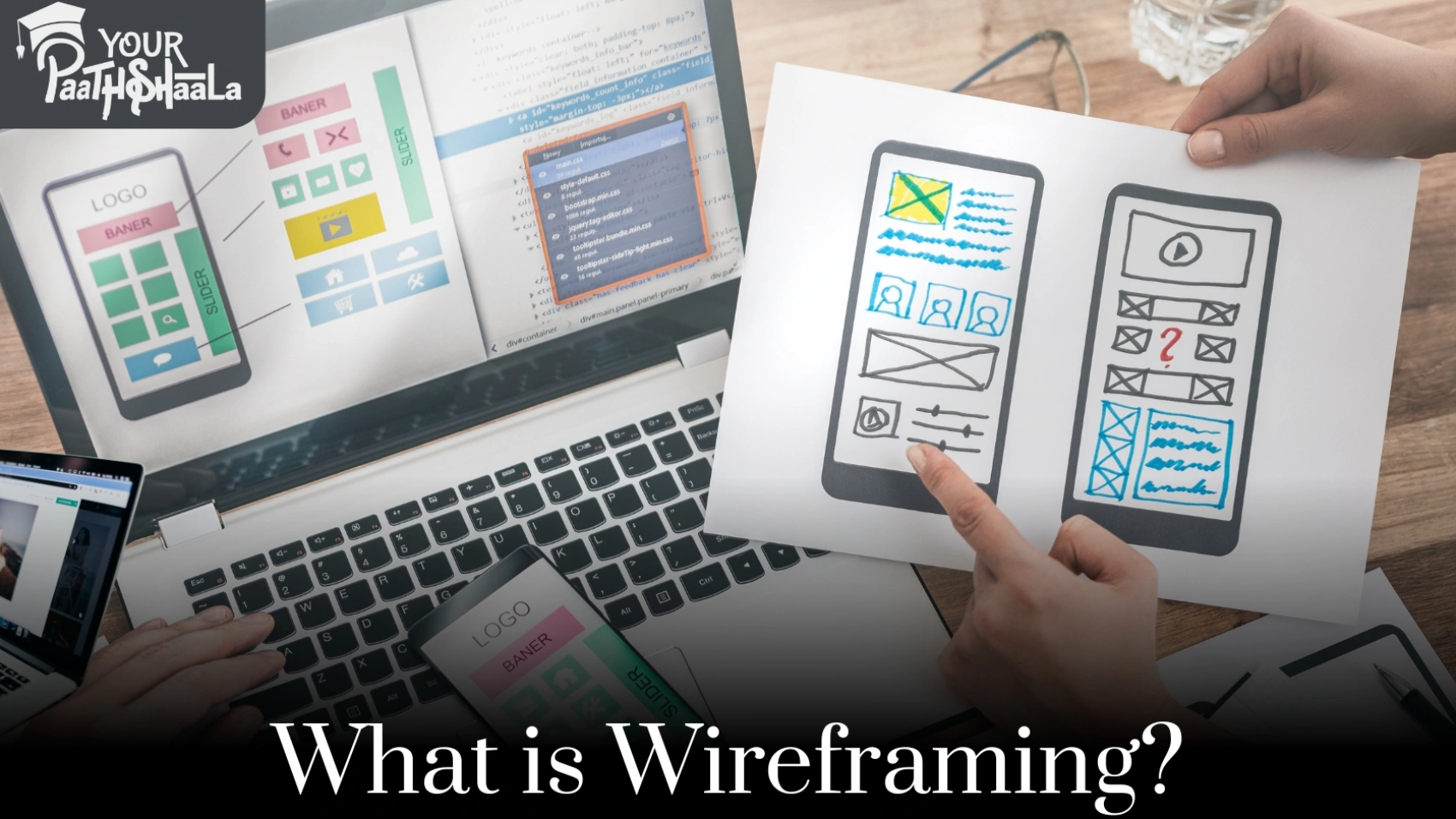Imagine a small business owner in Mumbai sketching a blueprint for their e-commerce website, mapping out where the “Buy Now” button goes and how shoppers will navigate festive deals—all before writing a single line of code. This is wireframing, the foundation of web design that ensures Indian websites captivate 750 million smartphone users in a $188 billion e-commerce market. For Indian web designers, wireframing is a critical skill to create user-friendly, mobile-first sites that resonate with diverse audiences, from urban shoppers in Delhi to rural entrepreneurs in Rajasthan.
Wireframing for Indian web designers is about crafting low-fidelity layouts to plan a website’s structure, functionality, and user experience (UX) before diving into design or development. In 2025, with 90% of India’s internet traffic coming from mobile devices and Google prioritizing mobile-first indexing, wireframing is key to building sites that drive engagement and sales. This beginner’s guide explores wireframing for Indian web designers, covering its basics, tools, real-world applications, challenges, and future trends. Whether you’re a student in Bengaluru or a freelancer in Chennai, this guide will help you master wireframing to create stunning websites.
What Is Wireframing?
Wireframing is the process of creating simple, visual blueprints of a website or app’s layout, focusing on structure, functionality, and user flow without detailed visuals like colors or images. Think of it as a digital sketch that maps out where navigation menus, buttons, images, and content will sit. For Indian web designers, wireframing ensures websites are intuitive, mobile-optimized, and aligned with local needs like multilingual support and UPI payments.
Key components of a wireframe include:
- Layout: Placement of headers, footers, and content areas.
- Navigation: Menu bars or buttons for easy browsing, critical for India’s thumb-driven mobile users.
- Content Blocks: Placeholder text or images to plan content hierarchy.
- Functionality: Mapping interactive elements like “Add to Cart” buttons or search bars.
- Annotations: Notes explaining features, like “Hindi toggle here.”
Example: A Kolkata boutique’s wireframe outlined a mobile-first homepage with a festive banner, UPI checkout, and Hindi navigation, streamlining development and boosting sales by 20%.
Why Wireframing Matters for Indian Web Designers
India’s digital landscape in 2025 makes wireframing essential:
- Mobile-First Market: 90% of internet traffic is mobile, requiring wireframes optimized for 360px–720px screens.
- Diverse Audience: With 22+ languages and urban-rural divides, wireframes must plan for localized UX.
- E-Commerce Growth: Wireframes for shoppable features like UPI integration drive conversions in a $188 billion market.
- Cost Efficiency: Early wireframing cuts development costs by 15–20% by avoiding revisions, per UXPin.
- SEO Benefits: Well-structured wireframes improve site navigation, boosting Google rankings.
Stat: Websites with wireframed UX see 30% higher engagement and 35% lower bounce rates in India, per WebEngage.
Types of Wireframes
Wireframes vary by detail level, each suited to different project stages:
- Low-Fidelity Wireframes: Basic sketches (e.g., pen-and-paper or Balsamiq) focusing on layout and structure, ideal for brainstorming.
- Mid-Fidelity Wireframes: Digital mockups with more detail, like button placements, but no colors or images, created with tools like Figma.
- High-Fidelity Wireframes: Detailed prototypes with interactive elements, often used for client approvals, built with Adobe XD.
Example: A Hyderabad startup used low-fidelity wireframes to plan a blog, then mid-fidelity ones in Figma to finalize e-commerce features, saving 10 hours of development time.
Best Free Wireframing Tools for Indian Designers
Free tools make wireframing accessible for beginners and budget-conscious Indian designers. Here are the top picks for 2025, with India-specific applications:
Figma: Collaborative and Versatile
Figma is a cloud-based, free tool for collaborative wireframing and prototyping.
- Features: Drag-and-drop interface, real-time collaboration, mobile preview, and free tier with unlimited projects.
- India-Specific Benefits: Supports Hindi fonts (e.g., Noto Sans Devanagari) and mobile-first templates for Android-heavy markets.
- Use Case: A Delhi freelancer used Figma’s free plan to wireframe a saree shop’s mobile site, collaborating with a client in real-time, launching in a week.
Pros: Free, collaborative, and beginner-friendly.
Cons: Limited offline access; free plan caps team size at three.
Tip: Use Figma’s community templates for Indian e-commerce layouts.
Canva: Visual and Simple
Canva, known for graphics, offers free wireframing via its website builder and design tools, aligning with your interest in Canva’s capabilities.
- Features: Drag-and-drop editor, templates for wireframes, and mobile previews.
- India-Specific Benefits: Festive templates (e.g., Diwali banners) and Hindi text support for localized designs.
- Use Case: A Chennai blogger used Canva to sketch a low-fidelity wireframe for a travel site, integrating Instagram links for social commerce.
Pros: Intuitive, vibrant templates, and free stock images.
Cons: Limited to basic wireframes; less robust for interactivity.
Tip: Start with Canva’s flowchart templates for quick wireframes.
Balsamiq: Low-Fidelity Focus
Balsamiq specializes in simple, sketch-style wireframes, perfect for beginners.
- Features: Free trial, hand-drawn style, and drag-and-drop components.
- India-Specific Benefits: Lightweight for budget laptops common in India, with easy export to developers.
- Use Case: A Pune startup used Balsamiq’s 30-day trial to wireframe a food delivery app, saving ₹5,000 on early UX planning.
Pros: Easy to learn, mimics hand-drawn sketches.
Cons: Free trial limited to 30 days; fewer advanced features.
Tip: Use Balsamiq for initial brainstorming before moving to Figma.
MockFlow: Cloud-Based Simplicity
MockFlow offers a free plan for basic wireframing with a focus on ease.
- Features: Free tier with one project, drag-and-drop UI, and mobile templates.
- India-Specific Benefits: Supports quick mockups for local businesses like restaurants or boutiques.
- Use Case: A Jaipur NGO used MockFlow to wireframe a donation page, launching it in days with zero cost.
Pros: Simple interface, free plan for small projects.
Cons: Limited features in free tier; less collaborative than Figma.
Tip: Export wireframes as PDFs to share with clients.
Pen and Paper: Offline and Free
Traditional sketching remains a powerful, free wireframing method.
- Features: Zero cost, flexible, and ideal for brainstorming.
- India-Specific Benefits: Accessible for rural designers with limited tech access; easy to share via WhatsApp scans.
- Use Case: A Bhopal freelancer sketched a wireframe for a local store’s site, digitizing it later in Canva for client approval.
Pros: Free, no learning curve.
Cons: Not scalable for complex projects or remote collaboration.
Tip: Use grid paper for consistent layouts.
Wireframing Strategies for Indian Websites
To create effective wireframes for Indian audiences, focus on these strategies:
- Mobile-First Design: Prioritize 360px–720px layouts for India’s 90% mobile traffic, ensuring thumb-friendly navigation.
- Localized UX: Plan for Hindi or regional language toggles and festive visuals (e.g., rangoli for Diwali), aligning with your interest in localized strategies.
- E-Commerce Features: Include shoppable buttons (e.g., “Pay with UPI”) and search bars for India’s $188 billion market.
- Fast Load Planning: Design lightweight layouts to suit 4G/5G networks, using placeholders for WebP images.
- Interactive Elements: Map out polls or AR try-ons to boost engagement by 25%, per WebEngage.
Example: A Bengaluru e-commerce startup wireframed a mobile site in Figma with UPI checkout and a Diwali quiz, increasing conversions by 18%.
Challenges and Solutions
Wireframing for Indian websites has hurdles:
- Device Diversity: Budget phones limit complex designs. Solution: Test wireframes on BrowserStack for Android compatibility.
- Cultural Nuances: Misaligned visuals can alienate users. Solution: Use local focus groups to validate designs.
- Collaboration Barriers: Remote teams need seamless tools. Solution: Use Figma’s cloud-based collaboration.
- Learning Curve: Beginners may struggle with digital tools. Solution: Start with pen-and-paper or Canva’s simple interface.
Stat: Wireframed sites reduce development time by 15%, saving ₹10,000–₹20,000 for small projects.
Future Trends for Wireframing in India
Wireframing will evolve beyond 2025:
- AI-Driven Wireframing: Tools like Figma’s AI plugins will auto-generate layouts for Indian e-commerce sites.
- Voice UX Planning: Wireframes will include voice search flows for Hindi queries, used by 40% of Indian users.
- Metaverse Integration: Designs will plan for virtual store links, aligning with immersive trends.
- Hyper-Local Focus: Wireframes will target Tier-II/III cities like Surat with 5G growth.
- Sustainable Design: Low-data wireframes will cater to eco-conscious users.
Projection: By 2027, 70% of Indian web designers will use AI-assisted wireframing tools, per Forbes.
Getting Started with Wireframing
Ready to wireframe your first Indian website? Follow these steps:
- Define Goals: Plan for e-commerce, blogging, or portfolio sites.
- Choose a Tool: Start with Figma for collaboration or Canva for simplicity.
- Sketch Low-Fidelity: Outline layout and navigation with pen-and-paper or Balsamiq.
- Add Details: Use mid-fidelity wireframes in Figma to map CTAs and content.
- Test Locally: Validate on mobile devices via BrowserStack, focusing on Indian Androids.
- Share with Stakeholders: Use Figma or MockFlow to present to clients or developers.
Example: A Chennai designer used Figma to wireframe a restaurant site with Tamil navigation and UPI buttons, launching in 10 days and boosting orders by 15%.
Tool Tip: Start with Figma’s free plan or Canva’s flowchart templates for quick wireframes.
Conclusion
In 2025, wireframing for Indian web designers is the cornerstone of building user-friendly, mobile-first websites that tap into a $188 billion e-commerce market. Free tools like Figma, Canva, Balsamiq, and MockFlow make wireframing accessible, enabling designers to plan localized, shoppable, and fast-loading sites for 750 million smartphone users. By prioritizing mobile layouts, cultural relevance, and interactive elements like quizzes, you can boost engagement by 30% and cut development costs. Challenges like device diversity and collaboration are manageable with the right tools and testing. With AI, voice UX, and metaverse trends on the horizon, wireframing is set to transform Indian web design. Start sketching your wireframe today and build websites that shine. What’s your wireframing plan for 2025? Share below and let’s create something amazing! At Bestdigitalmarketingcourseinraipur you will learn all about it and more.








